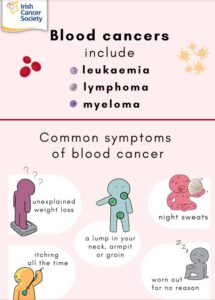If you are a family member or struggling with the cancer diagnosis, please get in touch with the Sligo Cancer Support Centre. You will find a caring and dedicated team offering you and your family one to one support, counselling, holistic therapies, various workshops and information in a peaceful and tranquil environment.
Blood cancers

Blood cancers affect blood cells. For example, leukaemia (white blood cells), lymphoma (lymphocyte cells) and myeloma (plasma cells).
There are a number of cancers that affect the blood. Our blood is made of different types of blood cells, which are made in the bone marrow in the middle of our bones. There are three main types of blood cells: red blood cells (which carry oxygen), platelets (which help blood to clot), and white blood cells (which fight infection).
When blood cancer occurs, normal blood cell development is affected by the uncontrolled growth of an abnormal kind of blood cell. These cancerous cells stop your blood from performing the functions it’s supposed to do, like fighting infections or clotting your blood when you’re cut.
Types of blood cancer:
Leukaemia
Lymphoma
Myeloma
Myelodysplastic syndromes (MDS)
1. Leukaemia
Leukaemia is cancer of your white blood cells and bone marrow. Bone marrow is the place where blood cells are made in your body. With leukaemia, immature blood cells divide quickly and do not grow into mature cells. These immature cells crowd your bone marrow and prevent it from making normal healthy cells.
Leukaemia can be divided into two main groups depending on how fast the disease develops: Acute leukaemia develops quickly, whereas chronic leukaemia develops more slowly. The word ‘acute’ does not refer to how successful the treatment will be.
The type of leukaemia also depends on which kind of white blood cell is affected. There are many different types of white blood cells. These include myeloid and lymphoid cells. Myeloid cells develop into red blood cells, white blood cells and platelets. Lymphoid cells develop into white blood cells called lymphocytes. As a result, there are 4 main types of leukaemia:
Acute lymphoblastic leukaemia (ALL)
It a fast-growing type of leukaemia (blood cancer), which affects lymphocyte white blood cells.
ALL is not a common cancer. About 50 people are diagnosed with ALL in Ireland every year. It is most common in adolescents and young people between the ages of 15 and 25. Click here for more information
Acute myeloid leukaemia (AML)
AML is a blood cancer more common in people aged over 65. More than 150 people are diagnosed with AML every year.
AML can be treated with chemotherapy and radiotherapy, targeted therapies and stem cell transplants. Click here for more information
Chronic lymphocytic leukaemia (CLL)
CLL is a type of leukaemia (blood cancer). It is usually a slow-growing cancer.
About 200 people in Ireland are diagnosed with CLL each year.
The main treatments for CLL are targeted therapies, chemotherapy and steroid therapy. Click here for more information
Chronic myeloid leukaemia (CML)
CML affects about 70 people in Ireland each year. It is more common in men than women.
It is treated with targeted therapies, chemotherapy, steroid therapy and stem cell transplants, depending on the type. Click here for more information
2. Lymphoma
Lymphoma is cancer of the lymphatic system. Generally, lymphoma cells grow in lymph glands (nodes). This causes the glands to get bigger or swell.
There are two types of lymphoma. One is called Hodgkin and the other is non-Hodgkin lymphoma. The difference between the two types depends on the appearance of the lymphoma cells under the microscope. Most lymphomas are non-Hodgkin lymphomas.
Hodgkin lymphoma
About 155 people are diagnosed with Hodgkin Lymphoma in Ireland each year. It occurs most often in young people between the ages of 15 and 30 and those over 65, but it can occur at any age.
Hodgkin lymphoma can be treated with chemotherapy, radiotherapy, steroids, targeted therapies and stem cell transplant.
For more information about Hodgkin lymphoma, click here
Non-Hodgkin lymphoma
Non-Hodgkin lymphoma is a cancer of the lymphatic system, which is part of the immune system.
About 830 people are diagnosed with non-Hodgkin lymphoma each year in Ireland. Lymphoma can occur at any age but it is more common in older people.
There are 2 main types of non-Hodgkin lymphoma: low grade and high grade.
For more information about Non-Hodgkin Lymphoma click here
3. Myeloma
Myeloma is a cancer of the plasma cells in the bone marrow. Normally, plasma cells make proteins called antibodies (immunoglobulins) to fight infection and help build up immunity to disease.
Multiple Myeloma
Multiple myeloma is a blood cancer affecting white blood cells made in bone marrow. Around 380 people are diagnosed with myeloma each year in Ireland. It usually affects people over 50.
Treatment for myeloma includes active monitoring or drug therapies.
For more information about Multiple Myeloma click here
4. Myelodysplastic syndromes (MDS)
Myelodysplastic syndromes (MDS) is a rare type of blood cancer sometimes referred to as bone marrow failure. All blood cells in a healthy person are made in the bone marrow. In MDS, your bone marrow makes a large amount of abnormal cells, so you don’t have enough healthy blood cells in your bloodstream.
In Ireland, around 180 people are diagnosed with MDS each year. It can be diagnosed at any age but is more common as people get older.
For more information about Myelodysplastic syndromes
Sources
https://www.cancer.ie/cancer-information-and-support/cancer-types/blood-cancers

